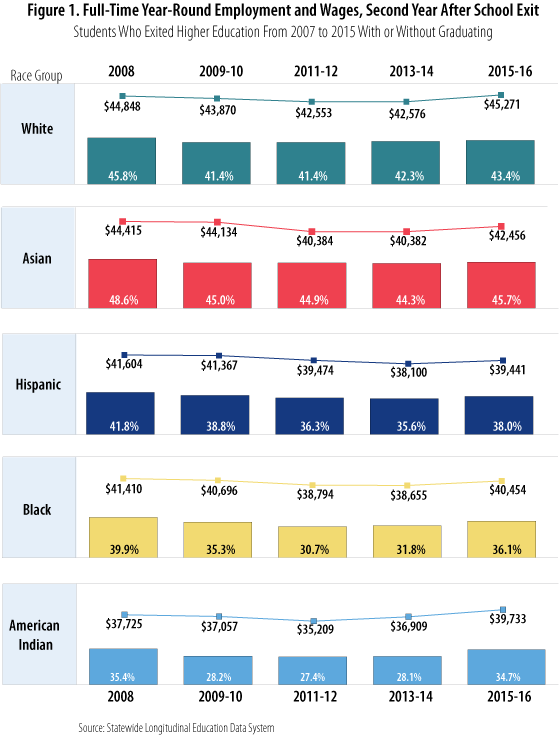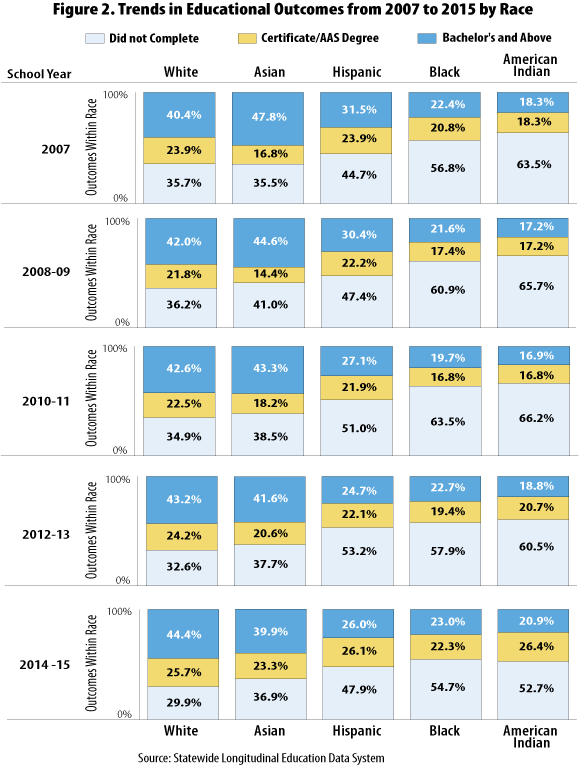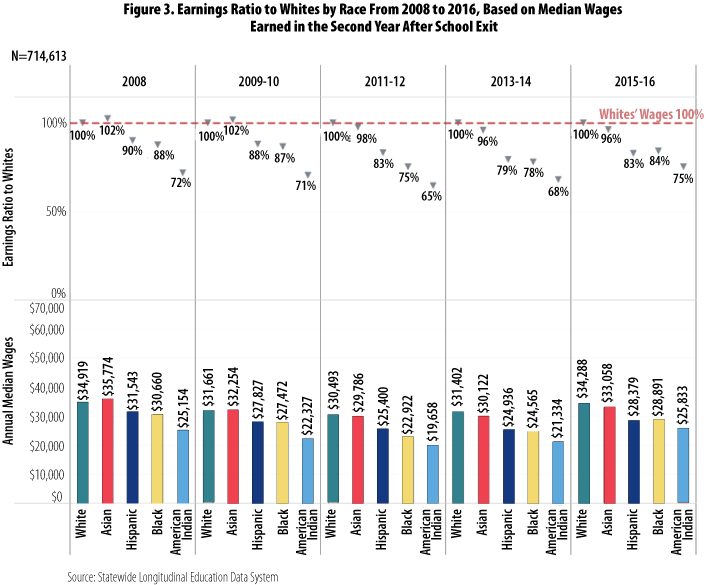
by Alessia Leibert
September 2018
Race was a factor in the ability of students to find employment after leaving higher education during and after the Great Recession.
The Great Recession did not affect all Minnesotans equally. Racial minorities, specifically American Indians and African Americans, were hit particularly hard. To understand the impact of the recession and subsequent recovery by race, we looked at people who attended Minnesota post-secondary institutions from 2006 to 2015 and left school with or without a credential.
The economic climate when students leave higher education clearly affects their ability to find stable employment and enter a career. Figure 1 illustrates this point by tracking the changes in full-time, year-round employment from 2008 to 2016 among students of different racial backgrounds who left college.

Full-time, year-round employment is an indicator of the health of the job market because work hours tend to increase when the economy expands and decrease during economic downturns as the demand for labor declines. It is also an indicator of job quality, because full-time jobs are more likely to provide important benefits like health care and retirement as well as career advancement opportunities.
Even before the recession, race was a factor in the ability of students to find a full-time job. Among white students who exited college in 2007 the incidence of full-time, year-round employment the year after (in 2008) was higher than most other race groups, at 45.8 percent. Then it sank to 41.4 percent in 2011-2012 before bouncing back to 43.4 percent by 2016. Black and American Indian former students were hit much harder, with full-time employment falling from 39.9 percent to 30.7 percent and from 35.4 percent to 27.4 percent, respectively, from 2008 to 2012.
Racial disparities are also evident in wage differences. Wages declined in 2009-10 across all racial groups, but full-time, year-round working white students consistently earned more than students of other races working similar hours. The decline in wages even among full-time workers stems from the fact that the jobs available to students right out of college paid less than those they would have qualified for before the downturn. As more experienced workers lost their jobs, they started crowding the entry-level job market that recent graduates relied upon. But the racial differences reported in Figure 1 suggest that, regardless of the ups and downs of the job market, as early as one year after college white students were more likely to be employed in jobs requiring a higher level of skills relative to students of other races who left in the same year.
Although black and American Indian students benefited greatly from the recovery, the last available data for 2015-16 show them lagging behind others on both indicators. Hispanic students consistently ranked in the middle between whites and Asians at one end of the spectrum and blacks and American Indians at the other end.
About the DataThis research relies on post-secondary enrollment and graduation records from the Statewide Longitudinal Education Data System (SLEDS), which covers all for-credit public and private programs in Minnesota. The dataset has 714,613 enrollees ages 19 to 50 at the time of exit who were either residents of Minnesota or had an employment record in the state after leaving college. These selection criteria mitigate the risk of treating as dropouts students who left the state and continued their educations elsewhere. Graduates who earned more than one degree in the same academic year were classified according to the highest degree obtained. The wage analysis presented in this article does not capture people who went to work for the federal government, owned their own small unincorporated business or left the state. Wage records are unavailable for these workers because they are not covered by Minnesota's Unemployment Insurance Program. Race/ethnicity is a self-reported category that includes the following options: Black or African American (black), American Indian or Alaska Native (American Indian); Asian; Hispanic/Latino (Hispanic); white. Asians include a broad spectrum of ethnic groups but the categories that students can select from do not provide any more detailed breakdown. This article does not distinguish between U.S. born and foreign born students. |
Why were some racial groups disproportionally hurt by the recession? A partial explanation can be found in the educational achievement gap. Racial differences in educational achievement were already strong before the recession hit. As shown in Figure 2, in academic year 2007 the overwhelming majority of white and Asian students completed a credential. Only one out of three – or 35 percent – did not graduate. In contrast, more than half of black and American Indian students – 56.8 and 63.5 percent, respectively – did not graduate. Whites and Asians were also much more likely than other races to complete a bachelor's degree or higher. In 2007, 40.4 percent of whites and 47.8 percent of Asian students graduated with a bachelor's degree or higher.

Another alarming finding is that completion rates of Hispanics, blacks and American Indians declined during the recession at the same time as those of whites and Asians increased. In 2010-11, 63.5 percent of black and 66.2 percent of American Indian students dropped out of school, while only 34.9 percent of whites did. What factors contributed to these opposing trends by race?
Structural differences in income level between race groups are a contributing factor. Looking at post-secondary students who attended a Minnesota public high school over the last 10 years we find that racial minorities were more likely to attend a low-income school defined as having 50 percent or more students eligible to receive free or reduced-priced lunches. Among students for whom this information is available, 49.7 percent of blacks, 42.6 percent of American Indians, and 25.5 percent of Latinos attended a low-income school versus 9.2 percent of whites. Asians are the most socio-economically diverse group, with high concentrations at the extremes of the spectrum: 42 percent attended a low-income school and 35 percent attended a high-income school (defined as having less than one third of students eligible for free/reduced price lunch). Low-income students must remain employed to afford college tuition, while those from wealthier families have enough resources to continue in college despite the lack of job opportunities. Since black and American Indian students are more likely to live in low-income households, they probably were more likely to be forced to drop out of school after losing a job. Educational outcomes for minority students improved in 2015-16 when tighter labor markets made it easier for them to get and keep jobs that helped them cover college costs.
The higher likelihood of dropping out during the recession could have set back the employment and earnings potential of blacks and American Indians by years. Evidence shows that a post-secondary credential increased the odds of finding a job during the recession. Table 1 looks at students who left college between July 2009 and June 2011 – when the unemployment rate in Minnesota peaked at 8 percent – and compares the outcomes of those who earned a sub-baccalaureate credential with those who dropped out without any credential. This analysis is limited to young students and looks at earnings from jobs held at any time during the year, which are lower than full-time, year-round earnings because they include people who worked part-time or in seasonal jobs.
Completers fared much better than non-completers on all measures. First, they were more successful in their job search, as shown by higher employment rates relative to non-completers both in the first and fourth year after graduation. Second, employed completers earned higher wages after exiting school than employed non-completers.
Racial disparities, however, are also evident in these measures. Whites, Asians and Hispanics had much better outcomes than their black and American Indian counterparts even if they did not complete a credential: 76.5 percent of white non-completers were employed after graduation versus 62.5 percent and 58 percent of black and American Indian non-completers, respectively. These disparities affected many people, considering that non-completers made up the overwhelming majority of the black and American Indian 2010-11 cohorts.
While young white students could choose to weather the crisis by spending additional time in school, young minority students were more likely not to complete higher education. This put them at a disadvantage for years to come, as shown by wage differentials four years after school exit. Black students who completed a credential in 2010-11 earned median annual wages of $25,737 while those who did not complete earned $18,349.
Figure 3 wraps up our discussion by tracking trends in the earnings ratio between whites and other race groups from before to after the recession. In 2008 white students earned median wages of $34,919. Blacks earned 88 percent and American Indians earned 72 percent of each dollar earned by whites. Asians are the only race group whose earnings surpassed those of whites, at 102 percent.

One reason for the high performance of Asians as a group is the presence of international students who enroll in graduate school after having already earned a college degree in their home countries. And one factor contributing to the low performance of American Indians is their high concentration in Greater Minnesota, where wages are lower than the Twin Cities metro. If we could redistribute students equally across regions, the earnings ratio to whites – though still low – would be almost the same for blacks and American Indians.
Initial gaps further worsened between 2009 and 2012. While the wages of whites fell from $31,661 to $30,493, the wages of students of color fell even more, causing a decrease in the earnings ratio relative to whites. By 2012, American Indians earned two-thirds (65 percent) of whites, and blacks earned 75 percent of whites. Gaps started to narrow in 2014 thanks to the economic recovery, but they did not return to pre-recession levels except in the case of American Indians. Still, in the years 2015-16 American Indians earned 75 percent of whites, a major difference. It will take more years of economic growth to alleviate the inequitable impact of the recession on racial wage gaps.
Finally, it is important to mention that the inequalities relative to whites vary by age and education level. They are least pronounced among bachelor's degree completers younger than 30 and most pronounced among non-completers older than 30, suggesting that policies aimed at increasing educational attainment can mitigate racial disparities especially when students finish before age 30.1
This study documented racial differences in labor market outcomes before, during and after the Great Recession using a variety of metrics. Students who left post-secondary school between 2010 and 2012 faced the toughest labor market in decades, but some race groups suffered significantly more than others, leading to wider racial disparities between 2010 and 2012. Gaps started to narrow again in 2014 thanks to the economic recovery.
By far the most extreme inequalities affected black and American Indian students, especially non-completers (see Table 1). This result is partially driven by differences in socio-economic status and college attendance behavior. White non-completers tend to leave when they are further ahead in coursework and have already accumulated marketable skills, while their counterparts (excluding Asians) are more likely to interrupt their studies when a weak job market increases the financial strain of paying for college.
| Table 1. Educational and Employment Outcomes Among Students Who Exited School from July 2009 to June 2011 Before Age 27 With No Credentials or With a Sub-baccalaureate Credential | |||||
|---|---|---|---|---|---|
| Race Group | Graduation Status | Percent Employed First Year After School Exit* | First Year Annual Wages | Percent Employed Fourth Year After School Exit | Fourth Year Annual Wages |
| White (38,512) | Did not Complete (22,728) | 76.5% | $14,672 | 69.8% | $25,192 |
| Completed a Certificate or Associate Degree (15,784) | 85.8% | $18,109 | 80.3% | $32,221 | |
| Asian (2,466) | Did not Complete (1,642) | 76.2% | $15,247 | 76.2% | $27,755 |
| Completed a Certificate or Associate Degree (824) | 85.6% | $18,115 | 85.3% | $31,622 | |
| Hispanic (1,810) | Did not Complete (1,272) | 71.1% | $13,701 | 69.4% | $24,442 |
| Completed a Certificate or Associate Degree (538) | 83.3% | $18,039 | 77.9% | $29,387 | |
| Black (4,081) | Did not Complete (3,379) | 62.5% | $11,661 | 60.9% | $18,349 |
| Completed a Certificate or Associate Degree (701) | 77.8% | $14,927 | 73.4% | $25,737 | |
| American Indian (797) | Did not Complete (660) | 58.0% | $11,452 | 56.8% | $16,971 |
| Completed a Certificate or Associate Degree (137) | 75.9% | $14,218 | 72.3% | $23,540 | |
| *This analysis excludes students who were not resident in Minnesota because they are more likely to leave the state after school and bias the employment rates downwards. Even with this exclusion we see declines in the employment rates four years after school exit, probably because some residents left the state. | |||||
| Source: Statewide Longitudinal Education Data System | |||||
Policies aimed at increasing retention and college affordability among students of color could alleviate these disparities. Ending disparities in higher education, however, is not enough to address those originating in the workplace. The barriers that prevent certain racial minorities from securing a full-time, stable job after exiting higher education are not fully explained by differences in educational characteristics.
A possible explanation to the observed large disparities among non-completers during the recession is that racial discrimination by employers is more prevalent in the low-skilled labor market during economic downturns. In contrast, in a tight labor market employers perceptions — including racial bias — tend to have less influence on hiring decisions.
This evidence represents a warning and a lesson for the future. Since racial minorities are the fastest-growing segments of Minnesota's workforce, their greater vulnerability to the ebbs and flows of the business cycle is concerning. Addressing existing racial inequalities in educational achievement and access to full-time employment is critically important not only for the economic security of families and communities but for the economy as a whole.
1For more detailed results and interpretation, see Graduate Outcomes Dashboard by Race.